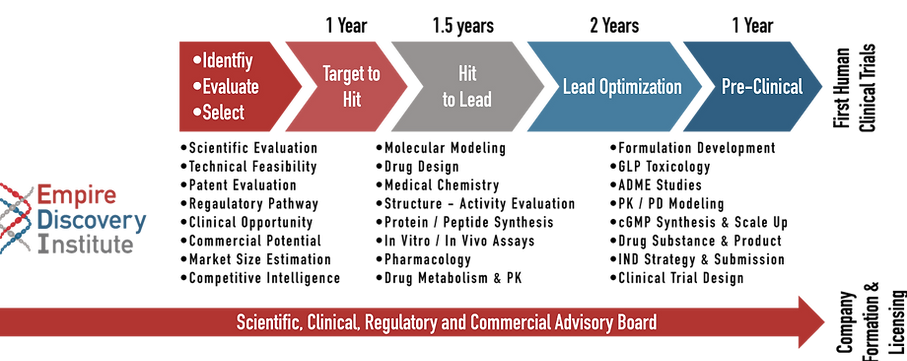
OUR
Approach
E V A L U A T I O N C R I T E R I A
EDI applies a “Market-back, Science-forward” approach when evaluating and selecting projects for investment. All applications into the EDI incubator and accelerator program are evaluated on the following criteria:
1.
Critical unmet need within a given disease or therapeutic area
2.
Alignment with the pharmaceutical industry’s top therapeutic research areas of interest in terms of strategic and commercial value
3.
Program competitiveness with respect to the nature and stages of development of comparable programs aimed at similar therapeutic profiles
4.
Market size opportunities and projected revenue streams within key global markets (US, EU, Japan/Asia)
5.
In-depth analysis of a program’s scientific and technical feasibility combined with an accurate prediction of technical and commercial success
6.
Assessment of a program’s IP strength and the ability to develop a strong IP position through freedom to operate analyses and defensible composition of matter and/or methods of use patents
7.
Likelihood of achieving early “proof-of-concept” through the application of quantitative measures of surrogate efficacy (i.e. biomarker driven outcomes) and early demonstration of appropriate “drug-like” properties (i.e. physicohemical characteristics, drug metabolism/PK (ADME) properties, and the ability to formulate)
8.
Program’s clinical and regulatory pathway to product approval
9.
Enthusiasm and commitment level of the project investigator(s) who would be expected to regularly engage with EDI’s advisory board, external innovation partners, investors, and prospective pharmaceutical partners in a collaborative and entrepreneurial venture

S T A G E S O F S U P P O R T

It is anticipated to take approximately 5 years to advance a molecule from Stage 2 (Target to Hit) to Stage 5
(Pre-Clinical Development) with the completion of IND-enabling regulatory studies to facilitate clinical testing.
Stage 1: Discovery Biology
• Programs at the discovery biology stage will typically be too early for EDI support
• EDI staff will be happy to meet with investigators at this stage to discuss future applications
Stage 2: Target to Hit (minimum entry into EDI)
-
Demonstration of a novel (ideally validated) target or pathway relevant to human disease
-
Identification of a probe molecule (or initial proof of concept in e.g. knock-in/knock-out model)
-
Hit ID through High Throughput-Screening (HTS), fragment screen, focusing screen, virtual screen, NMR screen, structure aided drug design, etc.
-
A “Hit” is defined as a compound with the desired activity in a screen that is confirmed on re-testing
-
Patent application made or granted or unpublished composition of matter ready for patent application
Stage 3: Hit to Lead
• Refinement of Hit series; establish “Structure-Activity Relationships” (SAR)
• Introduction of “drug-like properties” (solubility, lipophilicity / permeability)
• Improved potency/selectivity in vitro
• Initial Pharmacokinetic (PK) profile
• Initial demonstration of efficacy in vivo
Stage 4: Lead Optimization
• Conduct Lead Optimization by maintaining/increasing efficacy of analogues while improving deficiencies
• Minimize/eliminate hERG, CYP, transporter liabilities, etc.
• Minimize/eliminate “off-target” bindings (screen against panel of pharmacologically important receptors & enzymes, etc.)
• Improve stability & ability to formulate
• Establish Pharmacokinetic/Pharmacodynamic (PK/PD) relationships
• Improve PK and metabolic profile (ADME studies)
Stage 5: Pre-Clinical (IND Enabling) Regulatory Studies for Human Clinical Trials
•
•
•
•
•
•
•
•
•
•
•
•
Develop analytical methods for drug substance/drug product, stability testing and impurities (establish release criteria)
Scale-up chemistry for Toxicology batch and cGMP synthesis
Develop and validate bioanalytical methods for PK studies
Develop biomarker assays for assessing efficacy outcomes and for PK/PD studies
Conduct GLP toxicology (rodent & non-rodent); Single & multiple dose Toxicology and Toxicokinetic analysis
Conduct in vitro clinical pharmacology/drug-drug interaction studies (test CYPs & transporters)
Develop suitable formulation for Phase 1 trials
Select and test container/closures & develop drug packaging/labeling
Prepare Phase 1 trial plan & clinical protocol
Prepare regulatory strategy and write IND sections FDA submission
Prepare pre-IND meeting package and questions (conduct Pre-IND meeting)
Submit IND to FDA for regulatory review
E X A M P L E S O F S U P P O R T
Small Molecule Drug Discovery & Development
Typically, small molecule drug development programs will require comprehensive medicinal chemistry support through the process from “hit to lead” to “development candidate”. This will be accomplished through the engagement of consultants and contract research organizations (CROs) with e.g. high-throughput screening capabilities, advanced computational drug design capabilities and access to diverse compound libraries to serve as the starting point for the development and optimization of a new compound series.
EDI will also provide support for activities such as, assay development, in vitro and in vivo testing, formulation development, drug metabolism and PK, toxicology, drug substance and drug product scale-up/manufacture and regulatory affairs support as needed. EDI has identified and will contract with a number of strategic partners for these specialized pharmaceutical development services.
EDI’s SAB will also provide expert support to assist the discovery and development of biologic-based therapeutics, as well as gene-therapy, oligonucleotide and cell-based approaches as these opportunities are identified.
